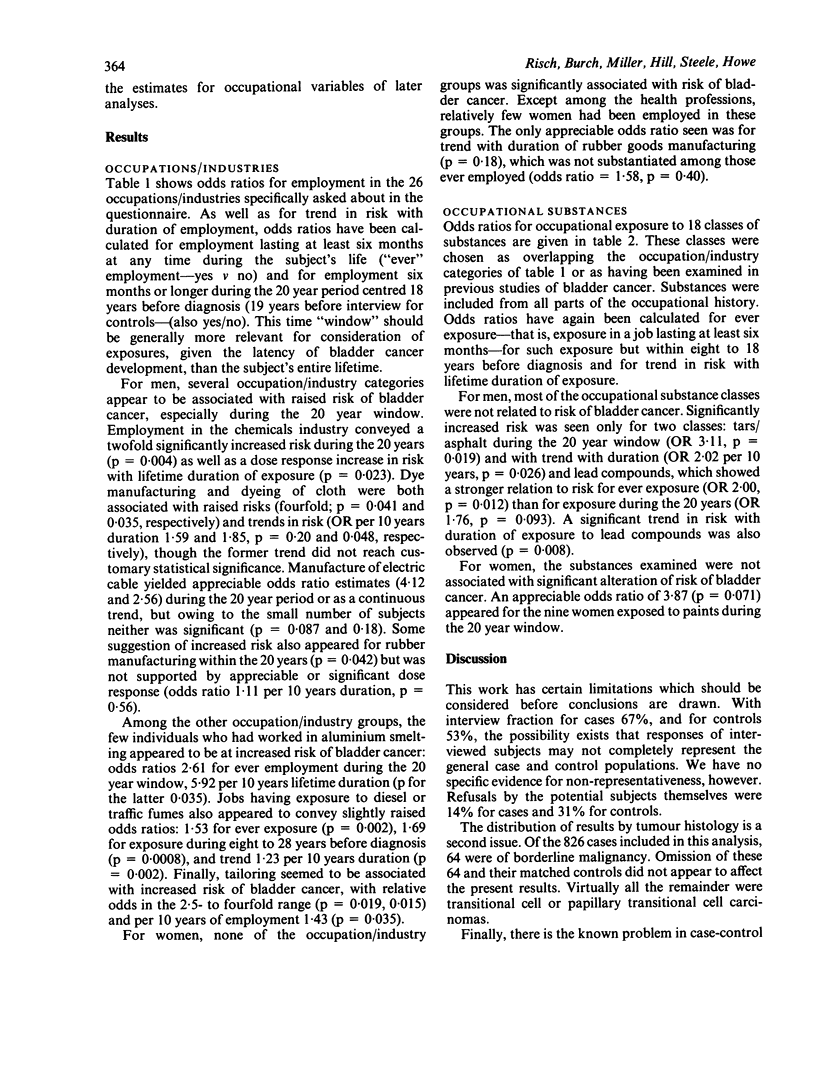Abstract
During 1979-82, a case-control study of occupational factors and urinary bladder cancer was conducted in Edmonton, Calgary, Toronto, and Kingston, Canada. A total of 826 histologically verified cases of cancer were individually matched by sex, age, and area of residence to 792 randomly selected population controls. Subjects were specifically asked about employment in several industries thought relevant to risk of bladder cancer. Information was also obtained on lifelong occupational history, with special attention given regarding exposures to fumes, dusts, smoke, and chemicals. In addition, subjects provided data on past medical and residential history, on intake of certain dietary items, and on exposure to tobacco and other lifestyle factors. Conditional logistic regression methods were used for the analysis. Under adjustment for cumulative lifetime cigarette consumption, it appeared that for both men and women, most of the occupational factors examined were not associated with significant alteration in risk of bladder cancer. For exposures during the period eight to 28 years before diagnosis, however, raised risk was suggested for men employed at least six months in the chemicals industry (odds ratio = 2.37, p = 0.004), in dye manufacturing or the dyeing of cloth (OR = 3.62 and 4.63, p = 0.041 and 0.035, respectively), as tailors (OR = 3.85, p = 0.015), or in jobs in which contact with diesel or traffic fumes occurred (OR = 1.69, p = 0.0008). Increased risk was also seen for men occupationally exposed to tars or asphalt (OR = 3.11, p = 0.019). This study then, at least for men, supports perhaps a few of the suspect industries as related to risk of bladder cancer.
Full text
PDF






Selected References
These references are in PubMed. This may not be the complete list of references from this article.
- Claude J., Kunze E., Frentzel-Beyme R., Paczkowski K., Schneider J., Schubert H. Life-style and occupational risk factors in cancer of the lower urinary tract. Am J Epidemiol. 1986 Oct;124(4):578–589. doi: 10.1093/oxfordjournals.aje.a114430. [DOI] [PubMed] [Google Scholar]
- Coggon D., Pannett B., Osmond C., Acheson E. D. A survey of cancer and occupation in young and middle aged men. II. Non-respiratory cancers. Br J Ind Med. 1986 Jun;43(6):381–386. doi: 10.1136/oem.43.6.381. [DOI] [PMC free article] [PubMed] [Google Scholar]
- Cole P., Hoover R., Friedell G. H. Occupation and cancer of the lower urinary tract. Cancer. 1972 May;29(5):1250–1260. doi: 10.1002/1097-0142(197205)29:5<1250::aid-cncr2820290518>3.0.co;2-t. [DOI] [PubMed] [Google Scholar]
- Decoufle P. Further analysis of cancer mortality patterns among workers exposed to cutting oil mists. J Natl Cancer Inst. 1978 Oct;61(4):1025–1030. [PubMed] [Google Scholar]
- Edling C., Kling H., Flodin U., Axelson O. Cancer mortality among leather tanners. Br J Ind Med. 1986 Jul;43(7):494–496. doi: 10.1136/oem.43.7.494. [DOI] [PMC free article] [PubMed] [Google Scholar]
- Gubéran E., Raymond L., Sweetnam P. M. Increased risk for male bladder cancer among a cohort of male and female hairdressers from Geneva. Int J Epidemiol. 1985 Dec;14(4):549–554. doi: 10.1093/ije/14.4.549. [DOI] [PubMed] [Google Scholar]
- Gérin M., Siemiatycki J., Kemper H., Bégin D. Obtaining occupational exposure histories in epidemiologic case-control studies. J Occup Med. 1985 Jun;27(6):420–426. [PubMed] [Google Scholar]
- Hanis N. M., Shallenberger L. G., Donaleski D. L., Sales E. A. A retrospective mortality study of workers in three major U.S. refineries and chemical plants. Part 1: Comparisons with U.S. population. J Occup Med. 1985 Apr;27(4):283–292. [PubMed] [Google Scholar]
- Hoar S. K., Morrison A. S., Cole P., Silverman D. T. An occupation and exposure linkage system for the study of occupational carcinogenesis. J Occup Med. 1980 Nov;22(11):722–726. [PubMed] [Google Scholar]
- Howe G. R., Burch J. D., Miller A. B., Cook G. M., Esteve J., Morrison B., Gordon P., Chambers L. W., Fodor G., Winsor G. M. Tobacco use, occupation, coffee, various nutrients, and bladder cancer. J Natl Cancer Inst. 1980 Apr;64(4):701–713. [PubMed] [Google Scholar]
- Kabat G. C., Dieck G. S., Wynder E. L. Bladder cancer in nonsmokers. Cancer. 1986 Jan 15;57(2):362–367. doi: 10.1002/1097-0142(19860115)57:2<362::aid-cncr2820570229>3.0.co;2-f. [DOI] [PubMed] [Google Scholar]
- Marrett L. D., Hartge P., Meigs J. W. Bladder cancer and occupational exposure to leather. Br J Ind Med. 1986 Feb;43(2):96–100. doi: 10.1136/oem.43.2.96. [DOI] [PMC free article] [PubMed] [Google Scholar]
- Meigs J. W., Marrett L. D., Ulrich F. U., Flannery J. T. Bladder tumor incidence among workers exposed to benzidine: a thirty-year follow-up. J Natl Cancer Inst. 1986 Jan;76(1):1–8. [PubMed] [Google Scholar]
- Piper J. M., Matanoski G. M., Tonascia J. Bladder cancer in young women. Am J Epidemiol. 1986 Jun;123(6):1033–1042. doi: 10.1093/oxfordjournals.aje.a114331. [DOI] [PubMed] [Google Scholar]
- Rushton L., Alderson M. R. An epidemiological survey of eight oil refineries in Britain. Br J Ind Med. 1981 Aug;38(3):225–234. doi: 10.1136/oem.38.3.225. [DOI] [PMC free article] [PubMed] [Google Scholar]
- Sorahan T., Parkes H. G., Veys C. A., Waterhouse J. A. Cancer mortality in the British rubber industry: 1946-80. Br J Ind Med. 1986 Jun;43(6):363–373. doi: 10.1136/oem.43.6.363. [DOI] [PMC free article] [PubMed] [Google Scholar]
- Vineis P., Magnani C. Occupation and bladder cancer in males: a case-control study. Int J Cancer. 1985 May 15;35(5):599–606. doi: 10.1002/ijc.2910350506. [DOI] [PubMed] [Google Scholar]


